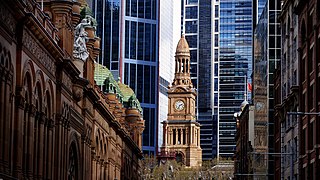
The architecture of Sydney, Australia’s oldest city, is not characterised by any one architectural style, but by an extensive juxtaposition of old and new architecture over the city's 200-year history, from its modest beginnings with local materials and lack of international funding to its present-day modernity with an expansive skyline of high rises and skyscrapers, dotted at street level with remnants of a Victorian era of prosperity.

Canning Downs was the first residential establishment built by a white person on the Darling Downs in Queensland, Australia. It is located a short drive from the town of Warwick and originally extended south east to Killarney and the McPherson Range. The area was first named after the British statesman George Canning by Allan Cunningham.

Cooma Cottage is a heritage-listed former farm and tuberculosis sanatorium and now house museum and historic site in the Southern Tablelands region of New South Wales in Australia. It is located on Yass Valley Way at Marchmont and was built from 1830 to 1837 by Cornelius and Rebecca O'Brien. It is also known as Hamilton Hume's House,Humedale Stud, and New Nordrach Institute for Consumption. The property is owned by the National Trust of Australia (NSW). It was added to the New South Wales State Heritage Register on 1 March 2002.
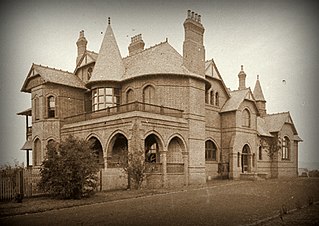
Camelot is a heritage-listed former residence, race horse stud and homestead and now large home located at Kirkham Lane in the outer south-western Sydney suburb of Narellan, New South Wales, Australia. It was designed by John Horbury Hunt and built from 1881 to 1888. It is also known as Camelot and Kirkham. It was added to the New South Wales State Heritage Register on 2 April 1999.

The Treasury Building, or the Colonial Treasury Building, The Old Treasury Building, or the Treasury Building & Premier's Office, is a heritage-listed former government administration building and now hotel located at the junction of Macquarie and Bridge streets in the central business district of Sydney in New South Wales, Australia. Commenced in 1849 and completed in stages in 1851, 1853, 1900 and 1919 in the Victorian Neo-Classical and Italian Palazzo styles by NSW Colonial and Government architects Mortimer Lewis, Edmund Blacket, Walter Liberty Vernon, and George McRae, the building has been used variously by the NSW Treasury, the Audit Office, the Premier's Department, the Police Department, and the Ministry of Transport. In 1981 the building was sold to the InterContinental Hotel group, with a major hotel complex built on part of the site and much of the heritage building restored.
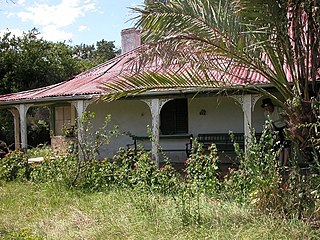
Cliefden is a heritage-listed homestead at 1521 Belubula Way, Mandurama, in the Central West region of New South Wales, Australia. It is one of a group of historic sites labelled the Ben Hall Sites for their association with bushranger Ben Hall, along with Ben Hall's Death Site, the Bushranger Hotel, Escort Rock, the Grave of Ben Hall and Wandi. It was built from 1842. It was added to the New South Wales State Heritage Register on 8 October 2010.
The Murray Downs Homestead is a heritage-listed homestead at Moulamein Road, Murray Downs, Murray River Council, New South Wales, Australia. It was built by Seutorius Henry Officer and Charles Officer ; and by Alfred Felton and Charles Campbell. The property is privately owned and as of 2024 the Homestead is no longer open for public inspection. It was added to the New South Wales State Heritage Register on 17 November 2000.

Lansdowne Park is a heritage-listed homestead at Bungonia Road, Goulburn, Goulburn Mulwaree Council, New South Wales, Australia. It was built from 1822 to 1825. It is also known as Lansdowne. It was added to the New South Wales State Heritage Register on 2 April 1999.

Berrilea is a heritage-listed residence at 29 Summer Street, Orange in the Central West region of New South Wales, Australia. It was designed by John Job Copeman and built by J. H. Gain. It is also known as Berrilee and Tabratong. The property is owned by the Uniting Church in Australia. It was added to the New South Wales State Heritage Register on 2 April 1999.

The Horsley complex is a heritage-listed former vineyard, orchard, horse breeding farm and stock breeding farm and now residence and pastoral property at 52–58 Jamieson Close, Horsley Park, City of Fairfield, New South Wales, Australia. It was built from 1805 to 1832. It is also known as Horsley complex , Horsley Park, King's Gift and Horsley House. It was added to the New South Wales State Heritage Register on 2 April 1999.
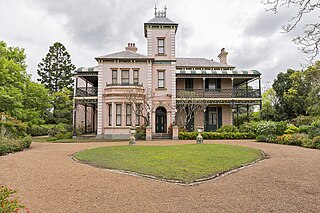
Cintra House is a heritage-listed residence and one-time private hospital at 34 Regent Street, Maitland, in the Hunter Region of New South Wales, Australia. It was designed by John Wiltshire Pender with a garden by Sydney landscape architect R. Culbert. It was built from 1879 by Robert James with an 1887 extension by H. Noad. It is also known as Cintra. It was added to the New South Wales State Heritage Register on 31 August 2012.

East Maitland Post Office is a heritage-listed former post office at 18 Day Street, East Maitland, City of Maitland, New South Wales, Australia. It was built in 1870. It was added to the New South Wales State Heritage Register on 2 April 1999.
Whitley is a heritage-listed residence at 217 Oldbury Road, Sutton Forest, Wingecarribee Shire, New South Wales, Australia. It was built from 1887 to 1892. It was added to the New South Wales State Heritage Register on 2 April 1999.
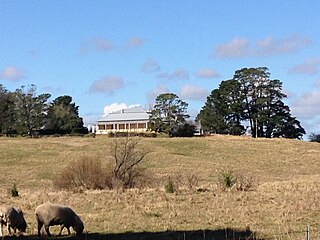
Throsby Park is a heritage-listed homestead at Church Road, Moss Vale, Wingecarribee Shire, New South Wales, Australia. It was built from 1820 to 1836. The property is owned by the Historic Houses Trust of New South Wales, but is leased to banker Tim Throsby of Barclays, a descendant of the original owners. It was added to the New South Wales State Heritage Register on 2 April 1999.

Shubra Hall is a heritage-listed former semi-rural suburban estate and mansion residence and now administration building for school purposes at Boundary Street in the Sydney suburb of Croydon, Municipality of Burwood, New South Wales, Australia. It was designed by Albert Bond and built from 1869 to 1888 in the Victorian Second Empire architectural style. It is also known as Presbyterian Ladies' College, PLC Croydon and Hordernville. The property is owned by the Presbyterian Ladies' College, Sydney and was added to the New South Wales State Heritage Register on 19 December 2014.

Richmond Post Office is a heritage-listed former post office at 286 Windsor Street, Richmond, City of Hawkesbury, New South Wales, Australia. It was designed by Colonial Architect James Barnet and built from 1875 to 1888. The original building was built by a Mr. Johnson, with the second-story addition in 1888 added by Samuel Bought. It is also known as Richmond Telegraph and Post Office. It was added to the New South Wales State Heritage Register on 23 June 2000.

Fernhill is a heritage-listed former house and former inn located beside the Great Western Highway in Bowenfels, City of Lithgow, New South Wales, Australia. It was built from 1856 to 1859 by John Blackman. It is also known as Australia Arms Inn. The property is owned by National Trust of Australia (NSW). It was added to the New South Wales State Heritage Register on 2 April 1999. On 18 July 2019 it was sold as a residential property.

St Matthew's Anglican Church is a heritage-listed Anglican church building located at Moses Street, Windsor, City of Hawkesbury, New South Wales, Australia. It was designed by Francis Greenway and built from 1817 by convict labour. The property is owned by the Anglican Church Property Trust. It was added to the New South Wales State Heritage Register on 2 April 1999.
Hunter River Lancers Training Depot is a heritage-listed military installation at Allingham Street, Armidale, New South Wales, Australia. It was added to the Australian Commonwealth Heritage List on 22 June 2004.

St Peter's Anglican Church is a heritage-listed Anglican church and associated Sunday school, rectory, and cemetery at 384 Windsor Street, Richmond, City of Hawkesbury, New South Wales, Australia. It was designed by Francis Clarke and Edmund Blacket and built from 1836 to 1841 by James Atkinson (church). It is also known as St Peter's Anglican Church Group, St Peter's Church Group, Church, Rectory, Church Yard, Cemetery and Stables. It was added to the New South Wales State Heritage Register on 16 August 2019; and on the City of Hawkesbury local government heritage register, and listed on the New South Wales Heritage Database on 12 September 2012.


















